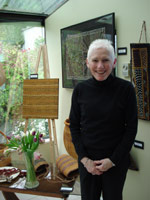By Shae Hadden
Bio
How often do we take time to look a little closer at beautiful works of
art? To learn about the culture that shaped the images we see? I
recently had an opportunity to visit a unique gallery in my community.
Founded and run by a Canadian who is committed to bringing Australian
Aboriginal art created by women to North America, the
Jan Townend Art Gallery
features paintings, textiles, weaving and basketry. The British art
critic John Ruskin once said, “All great art is the work of the whole
living creature, body and soul, and chiefly of the soul.” The powerful
paintings I saw at the gallery amply conveyed the soul of the
Aboriginal people—its beauty, strength and hidden meaning. The
deceptively simple style is grounded in a complex ceremonial tradition.
Consider that these people have no written languages, so their art is a
visual record, a way to communicate their history and culture: the
images help them tell their creation stories, their ‘dreamtime’, their
explanation of the world they live in. Pausing to view the creative
work of these women made me realize how my hectic, technology-driven
life has left me disconcertingly out of touch with my own soul. And in
speaking with Jan, I gained a greater understanding of what this art
means to the artists and their communities. Until the 1970s,
the Aboriginals painted on their bodies, on rock, bark, the ground and
on implements used for ceremonial purposes. Historically, an individual
had to earn the right to paint an idea, design, pattern or ‘dreaming’
from an elder. Men were predominantly the ‘sources’ of these dreamings.
In the early 70s, a white schoolteacher in Pupunya (west of Alice
Springs) introduced acrylics and canvas to the community. Adults and
children began to record their stories on this new surface, and the
wide variety of colours and mobility of this new medium began a major
shift—not only for the artists, but also for the whole fabric of the
communities. As their art became known and recognized around the world,
the work and the profits they realized had a profound effect on both
Aboriginal culture and society. Today, many female Aboriginal
artists paint while sitting on the ground, talking with each other
about old times and ways of living with the land, ways that have
endured more than 40,000 years. Some, without any formal training, have
created paintings that have been exhibited in Paris, New York, Zurich,
Singapore and beyond. Breaking tradition by expressing themselves in
this way, these women are empowering themselves: they are becoming
leaders, providing financial resources for their families and
communities, enabling people of all ages to heal and revitalize their
culture. And as the people change, their culture changes and so does
their art. These women are shifting their world, creating a legacy,
sharing their wisdom and their perspective, and courageously leading
the way for a whole new generation of Aboriginal women and children. What an inspiring way to make a difference…kudos to Jan for supporting these women and for bringing this art to us.
read more
